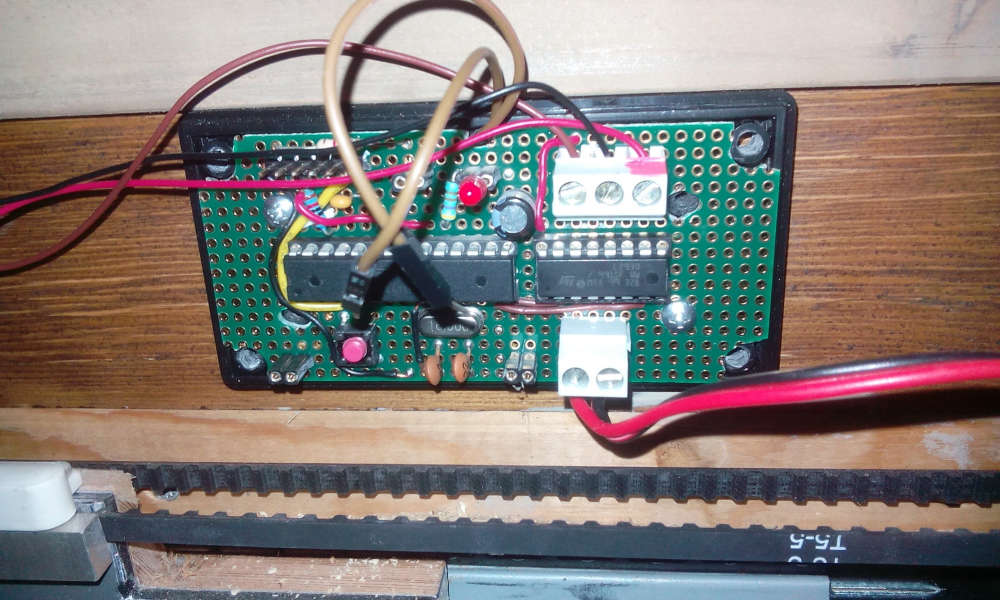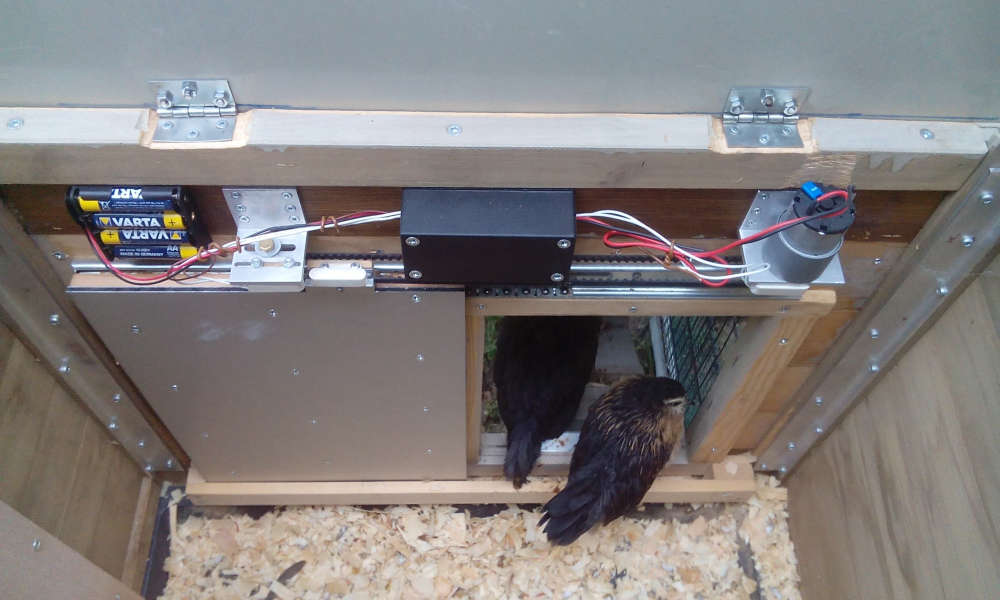Internet of Poultry - Fully automated chicken shed
-
@stefaanv
Solar Panel and Batteries
I'm all for matrimonial peace keeping!!
I'm just curious, why did you connect the INA219 DC current sensor directly to the battery and not the solar panel?@breimann
Just for fun, here is one of the evening recordings that is automatically stored on my Synology NAS every day. It provides evidence that the chickens were inside when the door closed. These recordings help me to set the correct ambient light level at which the door closes.
0_1472800935919_Evening take.mp4
It took some tuning, but this works really well now. The only times the chicks are not indoor when the door closes is on hot days when the temperature inside is still high in the evening. -
@stefaanv
Door mechanism and end of run contacts
This is great info!
A couple questions.- Are you just using standard door hinges x 2 on the door on the outside?
- Is that a magnetic latch you have once it closes to stop a chook accidentally (or deliberately?? ;)) pushing against it?
- Did you buy the motor with the tube to fit inside it and bracket or did you fashion that yourself?
Thankyou!
-
@breimann
By the way, in what part of the world in a chicken called a chook ? Austalia according to Google Translate ? Correct ? -
@breimann
By the way, in what part of the world in a chicken called a chook ? Austalia according to Google Translate ? Correct ? -
@breimann
Just for fun, here is one of the evening recordings that is automatically stored on my Synology NAS every day. It provides evidence that the chickens were inside when the door closed. These recordings help me to set the correct ambient light level at which the door closes.
0_1472800935919_Evening take.mp4
It took some tuning, but this works really well now. The only times the chicks are not indoor when the door closes is on hot days when the temperature inside is still high in the evening.@stefaanv
Love this recording. I love how you linked the recording to start 5 seconds before the door closes, and how you can see if there are eggs in your laying boxes and if the chooks are roosting!! Love it. Great thinking. What sort of camera are you using? -
@stefaanv
Love this recording. I love how you linked the recording to start 5 seconds before the door closes, and how you can see if there are eggs in your laying boxes and if the chooks are roosting!! Love it. Great thinking. What sort of camera are you using?@breimann
I'm using a cheap indoor dlink camera DCS-933L with night vision. One disadvantage : it can only be powered at 5V so I had to insert a DC/DC converter and it uses a lot of power (up to 200mA). So I only have it powered on about 1 minute every day. Just long enough for the NAS to pick up the signal and take a small clip.Great to have someone from the other side of the world interested in my project !!!
Now I'm really curious, since you walk upside-down compared to us, Do chook in Austalia sleep on top of the roost or do they hang heads-down from the roost ? :-) -
@breimann
I'm using a cheap indoor dlink camera DCS-933L with night vision. One disadvantage : it can only be powered at 5V so I had to insert a DC/DC converter and it uses a lot of power (up to 200mA). So I only have it powered on about 1 minute every day. Just long enough for the NAS to pick up the signal and take a small clip.Great to have someone from the other side of the world interested in my project !!!
Now I'm really curious, since you walk upside-down compared to us, Do chook in Austalia sleep on top of the roost or do they hang heads-down from the roost ? :-)@stefaanv
That's helpful re type of camera.
To shed light on your question re how chooks sleep on roosts in Australia... yes they do sleep upside down, a bit like a bat... but maybe bats don't sleep hanging upside down where you live?? ;)
No, gravity unfortunately (fortunately) hasn't taken a holiday here, so if they tried sleeping upside down i'm afraid their blood would all drain to their brains!! -
@bjacobse
OK, in Dutch a "kok" is a chef in a restaurant. However, they typically behave like male chickens, so that is not so far off. -
@stefaanv
That's helpful re type of camera.
To shed light on your question re how chooks sleep on roosts in Australia... yes they do sleep upside down, a bit like a bat... but maybe bats don't sleep hanging upside down where you live?? ;)
No, gravity unfortunately (fortunately) hasn't taken a holiday here, so if they tried sleeping upside down i'm afraid their blood would all drain to their brains!!@breimann
Here's the pictures of the cleaning. If you make a sliding bottom, do use mechanical sliders (I only have L-profiles) like the ones that are used in kitchen furniture. That way you'll be able to fully extend and your don't have to support the front. Do take care that the whole shed doesn't tip over.



-
@breimann
Here's the pictures of the cleaning. If you make a sliding bottom, do use mechanical sliders (I only have L-profiles) like the ones that are used in kitchen furniture. That way you'll be able to fully extend and your don't have to support the front. Do take care that the whole shed doesn't tip over.



-
May I ask, how do you get debug remotely? I also presume you're using the MYS bootloader?
Great project!
-
May I ask, how do you get debug remotely? I also presume you're using the MYS bootloader?
Great project!
@Mark-Swift
Nope, that's what the Fritz.box router is for. It has remote USB which I usb for the debugging. It's not ideal (always fails after computer hibernation) but it does the trick. -
I would love to see your sensor code. I am in the process building an automated door for my coop as well.
-
I would love to see your sensor code. I am in the process building an automated door for my coop as well.
@Nathan-Overley
Hi Nathan, it's not nice code, been written too quickly. I have to rewrite it some day. Still, here it is, it may give you idea's. Let me know if you improve it.
0_1477377889434_Kippenhok_3.ino -
@stefaanv
Thank you! I will definitely post my version when I get it done. I really appreciate you posting the code! -
Hello Stefaan,
Thanks for sharing your nice project !
How is it with the automatic door and your MySensors controller after 2 years ?Do you improved the code in the meanwhile and do you want to share it again ?
I made also an automatic (horizontal sliding) door on my coop with a barebone Arduino and a LDR as sensor, but I want the same functionalities like yours, so I ordered today all the extra necessary parts.


Kind regards and thanks in advance,
Peter.
